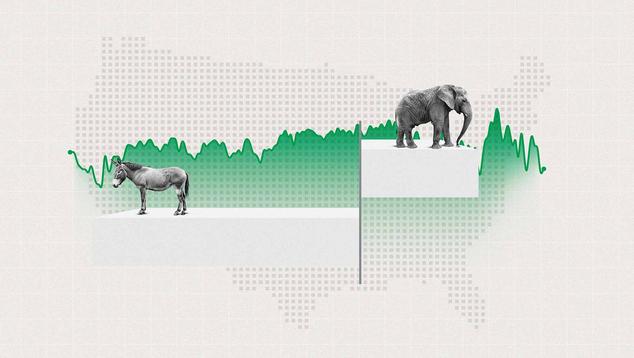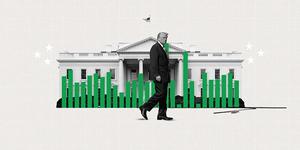WASHINGTON, D.C. — The percentage of U.S. adults evaluating their lives well enough to be considered “thriving” on Gallup’s Life Evaluation Index stood at 48.9% in Quarter 1, 2025, matching the previous estimate from Quarter 4, 2024, which was fielded in late November. These two levels mark the first time since spring 2020 that the thriving rate has been under 50% for two consecutive measurement periods and are two of just three sub-50% estimates ever to be measured outside of the Great Recession and COVID-19 eras.
Since reaching a record high of 59.2% in June 2021 — six months into the COVID-19 vaccine rollout — the thriving rate has now shed over 10 percentage points, projecting to an estimated 27 million fewer Americans who are thriving now compared with four years ago. These results are part of the Gallup National Health and Well-Being Index.
The most recent survey, conducted Feb. 18-26, 2025, included 5,876 U.S. adults surveyed by web as part of the Gallup Panel, a probability-based panel encompassing all 50 states and the District of Columbia.
For its Life Evaluation Index, Gallup classifies Americans as “thriving,” “struggling” or “suffering” according to how they rate their current and future lives on a ladder scale with steps numbered from zero to 10, based on the Cantril Self-Anchoring Striving Scale. Those who rate their current life a 7 or higher and their anticipated life in five years an 8 or higher are classified as thriving.
The thriving rate also dipped to 48.9% in Quarter 3, 2023, during Joe Biden’s presidency, the only other time outside of the Great Recession or the pandemic that it has dropped below the 50% threshold. This was possibly due to a notable increase in consumer inflation, and gas prices in particular, during the two months preceding the measurement period. By the following quarter, however, the thriving rate had bounced back to the same 52.2% reading that preceded it in the summer.
In all, the thriving trend line dating back to January 2008 is composed of 173 measurement periods.
Amid the drop in the thriving percentage, both metrics that constitute the Life Evaluation Index have declined since Quarter 3, 2024. But while the percentage of adults rating their current life a 7 or higher has edged down just two points to 63%, the percentage rating their anticipated life in five years has dropped five points since that time. As such, the decline in the thriving percentage is more greatly due to an erosion in hopefulness for the future than a change in immediate life satisfaction.
Life Ratings Jump for Republicans, Plummet for Democrats After Election
The decline in the thriving rate since Quarter 3, 2024, is not spread equally across different sectors of the U.S. population, including when sorting by political identity:
- Democrats have seen a decrease of 11 points, from 57.1% to 46.1%.
- Republicans have had a nearly five-point increase in their thriving rate, exceeding 55% each of the past two quarters.
- Independents — among whom typically less than half are thriving — are essentially unchanged from Quarter 3, at 47.9%.
These results are generally consistent with past shifts in life ratings among political partisans and other demographic subgroups upon a regime change in Washington.
Thriving Rate of 53.5% Is Key Cutoff for Change in Presidential Elections
Amid major declines in life ratings for Democrats since the 2024 election, the thriving rate has also proven to be a reliable predictor of regime change in U.S. presidential elections based on its historical average of 53.5% since the end of the Great Recession in June 2009.
In the months immediately preceding the November election, the U.S. thriving rate was 52.6%. The 2020 election during the COVID-19 pandemic was characterized by a thriving rate of 51.2% in the months immediately preceding the election that Biden won over Donald Trump. And in the months preceding the 2008 election, conducted during the Great Recession and financial crisis in which Democratic candidate Barack Obama was elected after eight years of Republican rule, the thriving rate was just 47.4%.
The 2016 election is an exception, when Trump defeated Hillary Clinton despite a historically strong thriving rate of 56.3%, well above the 53.5% average. The life evaluation-voting link, however, still appears to have played out at the subnational level in 2016. Prior research involving data from 599 U.S. counties showed a strong link between low or declining life ratings and shifts from Democratic support in 2012 to Republican support in 2016 in the U.S. presidential elections.
In a related analysis, Gallup has reportable data from 2013-2016 for 24 “pivot counties,” a subset of 206 total counties identified in an analysis by Ballotpedia that Trump won in 2016 after they had previously backed Obama in 2008 and 2012.
Using the 53.5% cutoff between “above average” and “below average,” 20 of the 24 reportable pivot counties (83%) had a thriving rate of 53.5% or less, with an average rate of just 50.1% during that period. Although insufficient data exist to reproduce this analysis with more recent elections, what was found among these 24 pivot counties in 2016 provides supportive evidence for how general life ratings can influence the voting habits of American adults.
In the months running up to the 2012 election, in which incumbent President Obama defeated Republican nominee Mitt Romney, the thriving rate was 53.1%, slightly below the 53.5% threshold but also substantially improved compared with the 47.4% measured four years prior.
Key Aspects of Wellbeing Are Primary Causes of Drop in Thriving Rate
The observed declines in life evaluation ratings can be explained primarily by changes in two metrics measured as part of the broader Well-Being Index, both of which are highly related to life ratings and have worsened since Quarter 3, 2024. This includes not worrying about money in the prior seven days, which shows a seven-point decline in agreement coupled with a similar increase in disagreement. The other is having “a leader in your life” who creates enthusiasm for the future, which shows a nearly four-point drop in agreement coupled with a five-point increase in disagreement.
Implications
As reported at the time, the second half of Biden’s presidency was characterized by languishing thriving rates that boded poorly for his reelection chances (as well as the prospects for Kamala Harris). That the already subdued levels of life ratings measured in 2022 through last fall have thus far slipped still further in 2025 makes for an increasingly troubling trend in Americans’ wellbeing. However, the thriving rate has shown itself capable of large swings in relatively short periods of time, as recently as 2020-2021 amid the pandemic. As such, the opportunity for significant improvement in U.S. wellbeing in the future remains intact.
While increasing money worries could reflect a sinking stock market and steady declines in consumers' economic confidence, decreasing agreement that leadership is creating enthusiasm for the future is more partisan. Compared with Quarter 3, 2024, Democrats have plummeted from 38% agreement to 25%, while Republicans (up three points to 43%) and independents (up one point to 29%) are mostly unchanged, indicating a likely Trump effect among those disinclined to support the president’s various policies and stated agenda.
To stay up to date with the latest Gallup News insights and updates, follow us on X @Gallup.
Learn more about how the Gallup National Health and Well-Being Index works.
Learn more about how the Gallup Panel works.




